

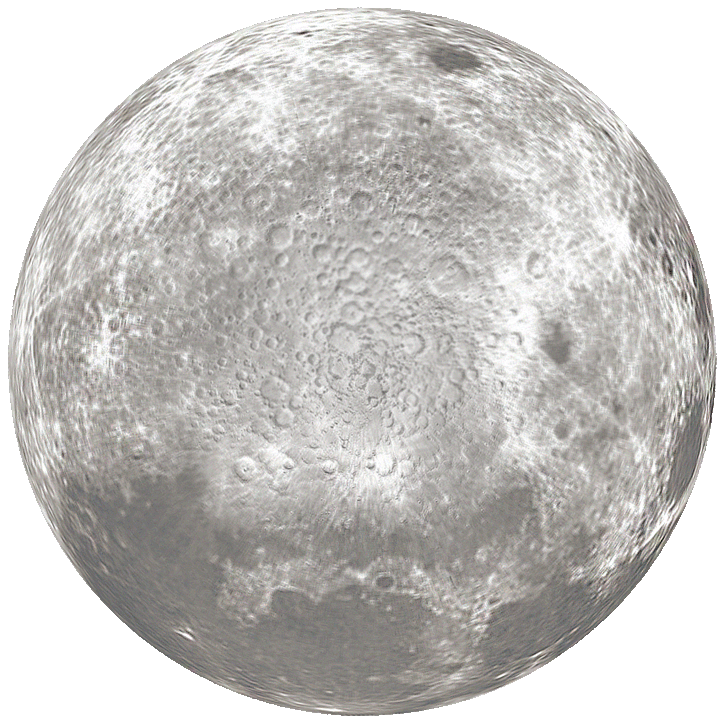


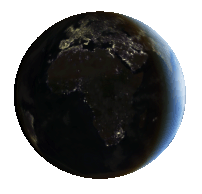

Moon's Position Over Earth
(to update, reload page)
Courtesy: Fourmilab Switzerland
Unlike Earth, the Moon is a barren, lifeless world with no liquid water and barely an atmosphere! (1.6.x) (1.4.1)
Essentially, the same side of the Moon always faces us! ![]() View from Earth: (1.6.x)
(1.4.1)
View from Earth: (1.6.x)
(1.4.1)
Because the Moon is nearer than any other major celestial body, it can produce dramatic "shadow events" like this! (1.6.x) (1.4.1)

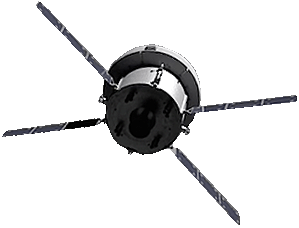
The Moon's surface area is a bit less than the area of Asia, Earth's largest continent, and a bit greater than the area of Africa, Earth's second largest continent!
ECLIPSES

Eclipses occur whenever the Moon or Earth moves into or through the other's shadow. This does not happen every month, as the lunar orbit is inclined to Earth's orbit. So Earth, the Sun and the Moon produce eclipses only about every 6 months. Calendar
During Solar Eclipses the Moon moves "directly" be- tween Earth and the Sun, so the lunar shadow extends down onto Earth's surface. Solar Eclipses can only:
happen at New Moon,
last a very short time,
be seen from small areas.
Current Sun vs Moon Sizes has more eclipse insights.
 WARNING! It is never safe to look directly at a Solar Eclipse with the naked eye! And looking at one, for even an instant, through a telescope or binoculars with- out adequate safeguards can cause permanent blindness! NEVER DO IT! To learn how to safely "observe" a Solar Eclipse, consult your local planetarium or observatory.
WARNING! It is never safe to look directly at a Solar Eclipse with the naked eye! And looking at one, for even an instant, through a telescope or binoculars with- out adequate safeguards can cause permanent blindness! NEVER DO IT! To learn how to safely "observe" a Solar Eclipse, consult your local planetarium or observatory.
During Lunar Eclipses the Moon moves directly behind Earth relative to the Sun, moving either partially or en- tirely into Earth's shadow. Lunar Eclipses:
happen at Full Moon,
can last for hours,
can be seen from over
half of our planet.
Main Types of Eclipses:
How a Solar Eclipse Looks from Space:
from "Day" Side
from "Night" Side
How a Lunar Eclipse Looks:
from the Moon
NASA Eclipse Data Website
NASA Eclipses
Wikipedia Eclipse page
UNL Eclipse Explorer
MOON LANDING SITES & SURFACE VIEWS
The links below open photos taken by Apollo astronauts in the 1960s and '70s, showing the various types of terrain encountered at the Apollo landing sites. The terrains chosen for successive mis- sions were increasingly more varied and more demanding.

Apollo 11 ![]() terrain quite
terrain quite
flat #2 #3 #4
Apollo 12 ![]() terrain fairly
terrain fairly
flat #2 at Surveyor ![]()
Apollo 14 Frau Maro high-
lands, boulders #2 #3
Apollo 15 rolling, hilly
terrain #2 #3 #4 #5
Apollo 16 hilly, furrowed
terrain #2 #3 #4
Apollo 17 hilly, rocky valley
#2 #3 #4 Big Rock
Apollo 11 Landing Site in 3-D
Alt+Drag moves shadows.
MOON MISSION TRAVERSE MAPS
These maps and pages show many details, including the routes taken by the Apollo astronauts as they explored the surface of the Moon. The Lunar Rovers were used from Apollo 15 onward and vastly extended the distances the astronauts could travel. So the scales of the maps vary.
Apollo 11
Map 2
Map 3
Apollo 12 (2 EVAs)
Map 2
Apollo 14 Map 2 Map 3
Map 4
Apollo 15
Map 2 ![]() Map 3
Map 3
Apollo 16 Map 2 ![]()
Apollo 17 Map 2 ![]() Map 3
Map 3
Compare similar views of the traverse maps with the cool History of Apollo Landings in 3-D. Zoom, tilt and rotate the views, etc. Awesome!
And here's an informative NASA graphic comparing the Distances Traveled by Moon and Mars Rovers. ![]()
Nice Moon Mission Poster.
MOON ACTIVITIES
MAP THE MOON
BY EYE
Here's a rewarding activity. First download and print out the NASA/JPL Moon Journal Worksheet ![]() . Then take a pencil and your worksheet out with you on succeeding nights and map the Moon: its phases, its surface features. Then, when the Moon is nearly Full, on the back of your worksheet sketch how it appears in a larger scale. Do it again a month later and compare your drawings. Were you able to draw a pretty good likeness of the Moon's dark areas, the maria (seas)?
. Then take a pencil and your worksheet out with you on succeeding nights and map the Moon: its phases, its surface features. Then, when the Moon is nearly Full, on the back of your worksheet sketch how it appears in a larger scale. Do it again a month later and compare your drawings. Were you able to draw a pretty good likeness of the Moon's dark areas, the maria (seas)?
Remember: it was only with the naked eye that any sky object could be observed un- til the invention of the tele- scope in the early 1600's!
MAP THE MOON
WITH BINOCULARS
Now, try mapping the Moon as you did above, this time with a pair of binoculars. Even a cheap pair will reveal much more detail. Compare your new maps with those you made when you mapped the Moon by eye alone.
Remember: until the advent of photography astronomers had to rely on the maps they drew by hand! Just like the maps you sketched above! So you're in good company.
MAKE A PAPER MODEL OF THE MOON!
CANON has a terrific website that offers free downloads of paper models, including this cool 3-D model of the Moon. The labeled globe will quickly acquaint you with the Moon's most prominent features and many great Moon facts!
MAKE A YARDSTICK SCALE MODEL OF THE EARTH-MOON SYSTEM
Ask your parents or a teacher to help you find a 1" diameter button (blue if possible), a #2 pencil with an eraser they'll permit you to break off, a few pieces of transparent tape, and a yardstick they'll permit you to write on.
Making your model is simple. 1.) Tape the button so its cen- ter overlaps the left edge of the yardstick. 2.) Tape the eraser so its center is 30 1/8" from the left edge of the yard- stick, and label it "Average Moon Distance". 3.) Label the button "Earth". 4.) Now, 27 7/8" inches from the but- ton's center, draw a vertical line and label it "Minimum Perigee". 5.) And to finish,
31 7/8" from the button's cen- ter, draw a vertical line and label it "Maximum Apogee".
You now have a surprisingly accurate scale model of the Earth-Moon System! More- over, you can easily take it anywhere! If permitted, you might even want to paint the yardstick black and add con- tinents to Earth and maria to the Moon!
Want to get even fancier? Use this view of the Earth-Moon system to add more details: the distance of Earth's geosynchronous satellites, and the average locations of 1) the Earth-Moon Barycenter, and 2) the Earth-Moon L1 Lagrange point!
VERIFY THAT THE MOON RISES ABOUT 50 MIN- UTES LATER EACH DAY
As you go about your obser- vations, it will be easy for you to verify that the Moon rises about 50 minutes later each day. Of course, this is an average. The actual time depends on your latitude and on the Moon's very irregular orbit.
VERIFY HOW EARTH'S TIDES ARE LINKED
TO THE MOON
Even the ancients knew that Earth's tides were influenced by the Moon. If you live near the coastline of an ocean or other large body of water, make observations of your own. Record how the water level differs when the Moon is rising, setting, high in the sky or hidden by Earth. You can also check it at different times of the year against the graph to the right and to this Perigee and Apogee List.
VERIFY THE
MOON'S PHASES
Here's an exercise that's fun to perform with friends and other sky enthusiasts. For a few evenings each week, for two or three weeks, observe the Moon and compare its phase to the ones predicted here or on other websites.
MEASURE THE NEXT SUPERMOON
Here's a cool group activity that you can suggest to your science teachers. NASA and JPL guide you through the fine points of Measuring a Supermoon!
VERIFY HOW THE MOON'S RISE & SET TIMES ARE RELATED
TO ITS PHASES
Just to the right in the center column of this page, you will see a list of the 8 major types of Moon phases. Hover over them to find when the Moon should rise and set for each phase. Then, with the Moon Phase Calendar you created above, find when the Moon will exhibit each of its major phases in the coming month. On the day of each, confirm that the Moon does indeed rise and set when it should for each phase.
MORE PAPER MODELS: APOLLO PROGRAM!
The same CANON website offers these free Apollo-era paper models:
Command-Service Module
Lunar Module
Lunar Roving Vehicle
Lunar Surface Diorama
NASA Spacesuits
Saturn V Rocket
Make them all!
MAKE A PAPER MODEL OF NASA'S NEW ORION SPACECRAFT
NASA's new spacecraft will take us back to the Moon and beyond: 3-D paper model of Orion. Be the first in your neighborhood to have this model of the future!
WHIP UP A MOON-
LIKE CRATER
Here's another group activity that you can suggest to your science teachers. NASA and JPL give you the recipe for making miniature Moon craters in the classroom! Great educational fun!
SIMULATE A CONVER-
SATION BETWEEN YOUR EARTH-BOUND SELF AND
A FRIEND ON THE MOON
Use the Earth-Moon Distance diagram 2/3 of the way up the page for this. Have a conver- sation with a friend, as if he or she is on the Moon! As in- dicated to the diagram's left, click to send photons to the Moon and back for the time delay between exchanges.
For your Earth-Moon conver- sation to be accurate, you must wait for each photon to depart Earth "and" return from the Moon before you each answer one another! Of course, counting "one-one thousand, two-two thousand, three three-thousand" in be- tween your exchanges with your friend works too.
For even more fun, try it with you and your friend facing away from each other or with a partition between you. Do you think you could get used to phoning a friend on the Moon like this?
The Apollo astronauts and Mission Control had to deal with precisely this time delay whenever crews were on the Moon or in orbit around it!
CELES-TIPS
The following will help you enjoy this page's 1.6.x and 1.4.1 links that run events directly in CELESTIA. If you're new to the program, these tips will also help you learn to use it.
Are you unfamiliar with our 1.6.x and 1.4.1 links? For an explanation click here.
You'll find more information about many of CELESTIA's controls on our Learning Center page.
THE MOON
View Moon in 3D ![]() 3-D in Orbit (from Sun's direction)
3-D in Orbit (from Sun's direction)
Moon Trek: for 3D Moon, at lower left of Trek window
select globe (Projections), then 3D Globe.
Current:
Orbital Position, Phase & Distance
Viewed from Earth: Appar. Size, Phase & Distance
Earth & Moon Viewed from Sun Interactive
Location in the Constellations
Your Moonrise, Moonset, Sunrise & Sunset today.
Physical Properties:
Equatorial Size: Compare Compare in 3-D
Radius: 1,738.1 km
Diameter: 3,476.2 km
Diameter (Earth = 1): 0.2725
View How Big Is Our Moon? video.
Compare to Other Moons
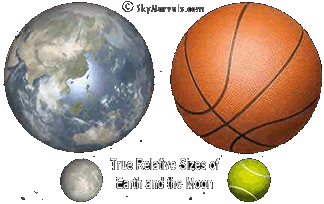
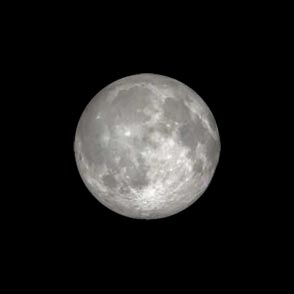
COMPARE MOON TO EARTH'S CONTINENTS
Rotational Flattening: 0.0012
Mass (Earth = 1): 0.0123
Volume (Earth = 1): 0.0203
Mean Density (Water = 1): 3.34
Mean Density (Earth = 1): 0.607
Surface Gravity (Earth = 1): 0.165
Surface Temperatures: average -23°C (-9°F) ![]()
Inclination of Axis to Orbit: 6.68°
Rotation and Revolution Period: (tidally "locked", so
the same side of Moon always faces Earth)
Synodic (in Earth days): 29.53 (cycle of Phases)
Sidereal (in Earth days): 27.3217
Note: Earth Day Lengths
Mean Solar: 24.0000 hours (24h00m00s)
Sidereal: 23.9345 hr (23h56m4.1s)
Albedo (geometric): 0.12
Magnetic Field (Earth = 1): extremely weak
More Views of Moon in 3-D:
NASA's Overview of the Moon
NASA's Moon Portal is similar but opens a few
different stories and interactive features.
History of Apollo Landings in 3-D zoom way in!
Moon-Viz gives you an appreciation for how many
satellites have studied and will study the Moon.
NASA's Moon to Mars
ESA's Lunar Exploration pages
Moon Surface:
LROC Quickmap
Moon Trek (Maps)
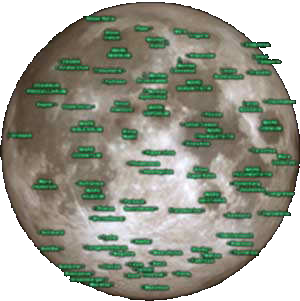
View the Moon's Features that are visible from Earth
with binoculars or a low-power telescope.
Moon-scapes in 3-D:
Apollo 11 Tsiolkovskiy Crater Petavius Crater
Copernicus Crater Hertzsprung Crater
THE MOON'S SLOW MONTH-LONG ROTATION
(from above lunar N Pole)
Download Moon maps to aid your viewing:
USAF Lunar Earthside Map (high-res)
NASA Apollo-Era Lunar Charts:
Polar and Equatorial (small)
Moon Landing Sites
Moon Internal Structure:
NASA Graphic
Compared to Earth & Mars ![]()
Compared to Inner Planets ![]()
How the Moon Formed poster
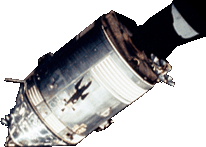
Spacecraft in 3-D:
Orion: #1 ![]() #2
#3
#4 #5
#2
#3
#4 #5
Altair Lunar Lander ![]()
Chang'e 3 ![]() Yutu (rover)
Yutu (rover) ![]()
Apollo:
Command & Service Modules: #1 #2
#3
#4
Interior: #1
#2 Combined (awesome): #1
Lunar Excursion Module:
#1
#2
#3
#4
#5
Luna 9 ![]() Lunokhod-2
Lunokhod-2 ![]()
Moon Orbit:
Current Lunar Orbit View from the Sun Interactive
Orbit highly variable: note amount and direction the
Moon strays from initial path. (1.6.x)
(1.4.1)
Wikipedia's Orbit of the Moon page
MOON DISTANCE: General Details
Distance: (Earth diameters are "equatorial")
Mean: 384,400 km (30.13 Earth dia.)
Perigee:
Mean: 363,300 km
Min: 356,400 km (27.9 Earth dia.)
Apogee:
Mean: 405,500 km
Max: 406,700 km (31.9 Earth dia.)
Perigee and Apogee List
Velocity: (around Earth)
Mean: 3,680 km/hr
(about as fast
as an SR-71)
Min: 3,480 km/hr
Max: 3,950 km/hr
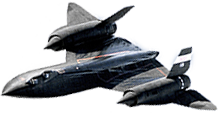
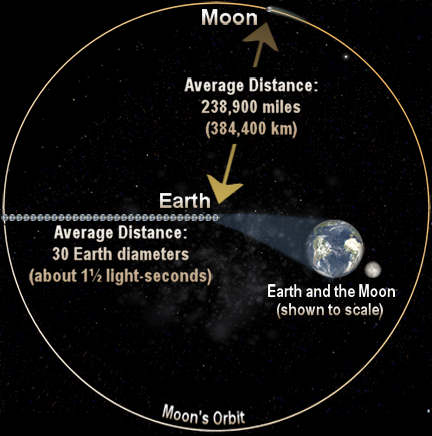 View Earth-Moon Barycenter video
View Earth-Moon Barycenter video
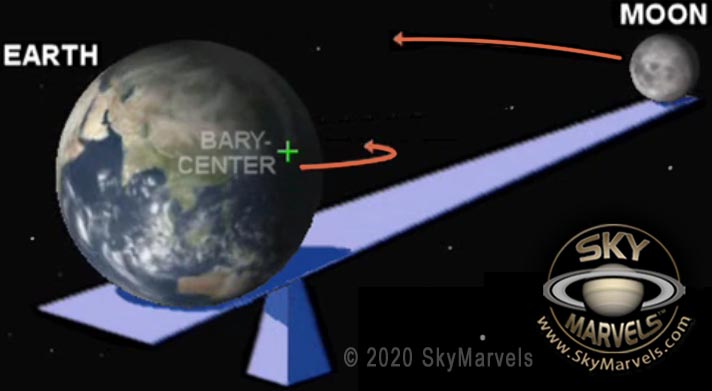
View Moon's Orbital Position & Phase video
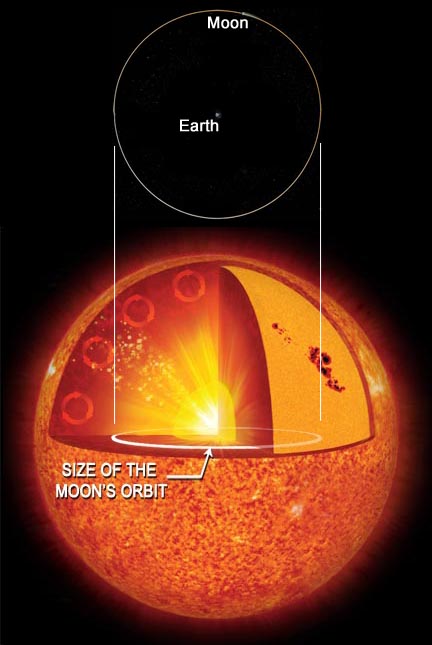
The lunar orbit would
easily fit inside the Sun!
The Moon's path around the Sun is
often shown incorrectly with loops or
zig-zags! Actually it is nearly a circle—
always concave relative to the Sun!
EARTH'S & THE MOON'S PATHS AROUND THE SUN
Scroll image above for the actual shape of the Moon's path around
the Sun. Click on image to open it fully in a separate window.
Lunar Orbit Periods: (Months)
Sidereal: 27.32166 days (relative to background)
Synodic: 29.53059 days (relative to Sun, Phases)
Tropical: 27.32158 days (relative to equinoxes)
Anomalistic: 27.55455 (relative to perigees)
Draconic: 27.21222 (relative to nodes)
THE MOON'S COMPLEX ORBIT AROUND EARTH
The Moon's orbit changes in complex
ways. Its plane and line of Nodes rotate "backwards" about every 18½ years! Its
line between perigee and apogee ro-
tates "forward" almost every 9 years!
And don't forget: every month
Earth and the Moon also revolve
once around their barycenter!
Long-Term Orbital Periods:
Precession of Apsides: 8.8504 years
Precession of Nodes: 18.5996 years (retrograde)
Spin-Orbit Resonance: Yes, 1 to 1
(so the same side of Moon always faces Earth)
Eccentricity:
Mean: 0.0549
Min: 0.0255
Max: 0.0775
Inclination to Ecliptic: 5.145°
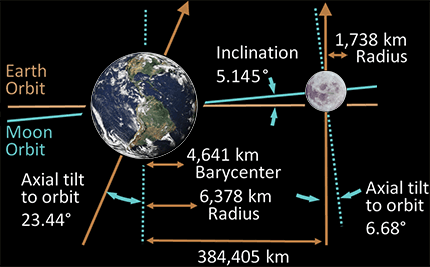
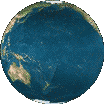

MOON'S SIZE VARIATION SEEN FROM EARTH
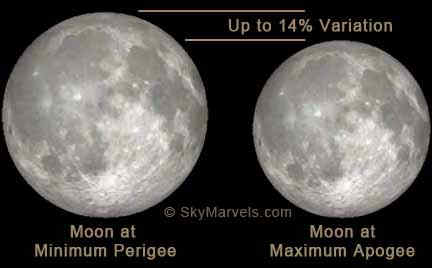
A "supermoon" occurs when the Moon is full
and in the closest 10% of its distance range.
Current Apparent Moon Size vs Sun Size
Supermoons:
Brightness:
Area Component: up to 15% greater than avg
Distance Component: up to 15% greater than avg
Cycle:
Pairs or Triples about every 13½ calendar months
Supermoons & Extreme Perigean Tides: 2020-2022

Moon Phases: ![]()
Current:
Orbital Position & Phase
View with Moon Phaser interactive tool
Distance, Apparent Size and Phase from Earth
Location in the Constellations
Study Phases with these interactives: #1 #2 #3
Lunar Phase Simulator
2025 Best Moon-Planet Conjunctions
MOON PHASES 2025
video credit: NASA's Scientific Visualization Studio
1.
![]() New MoonsNew Moons essentially rise and set with the Sun and reflect no sunlight toward Earth. So they do not impede Deep Sky Observing all night.
New MoonsNew Moons essentially rise and set with the Sun and reflect no sunlight toward Earth. So they do not impede Deep Sky Observing all night.
2.
![]() Waxing Crescent MoonsWaxing Crescent Moons generally
Waxing Crescent MoonsWaxing Crescent Moons generally
rise between sunrise and "local
noon". Setting between sunset
and "local midnight", they are up
and impede Deep Sky Observing
early in the evening.
3.
![]() 1st Qtr Moons1st Qtr Moons generally rise near "local noon". Setting near "local midnight", they are up and impede Deep Sky Observing for the first
1st Qtr Moons1st Qtr Moons generally rise near "local noon". Setting near "local midnight", they are up and impede Deep Sky Observing for the first
half of the night.
4.
![]() Waxing Gibbous MoonsWaxing Gibbous Moons generally
Waxing Gibbous MoonsWaxing Gibbous Moons generally
rise between "local noon" and sun-
set. Setting between "local midnight"
and sunrise, they are up and
impede Deep Sky Observing from
sunset through the early morning.
5.
![]() Full MoonsFull Moons generally rise near
Full MoonsFull Moons generally rise near
sunset, then set near sunrise. So
they are up and impede Deep Sky Observing all night long.
6.
![]() Waning Gibbous MoonsWaning Gibbous Moons generally
Waning Gibbous MoonsWaning Gibbous Moons generally
rise between sunset and "local
midnight". Setting between sunrise and "local noon", they are up and impede Deep Sky Observing in the
late evening through sunrise.
7.
![]() Last Qtr MoonsLast Qtr Moons generally rise near "local midnight" and set near "local noon", allowing Deep Sky Observing only during the first half of the night.
Last Qtr MoonsLast Qtr Moons generally rise near "local midnight" and set near "local noon", allowing Deep Sky Observing only during the first half of the night.
8.
![]() Waning Crescent MoonsWaning Crescent Moons generally
Waning Crescent MoonsWaning Crescent Moons generally
rise between "local midnight" and
sunrise. Setting between "local
noon" and sunset, they are up and
impede Deep Sky Observing only during the early morning.
QUICK VIEW OF 2025
MOON PHASES & ECLIPSES (UTC)
SOLAR: P = Partial LUNAR: T = Total
Click on months for Phases and Eclipses
2025 Phase List plus more Astronomical Events
Old Format Previous Months' Phase Calendars:
2014:
Jan
2013:
Dec
Nov
Oct
Sep
Aug
Jul
Jun
May
Apr
Mar
Feb
PRIOR AWESOME U.S. TOTAL SOLAR ECLIPSE:
2024 April 8 Maps Videos
SOLAR ECLIPSE QUICK REFERENCE MAPS
2001-2020 2021-2040 2041-2060
 KEEP SAFE! It is never safe to look directly at
KEEP SAFE! It is never safe to look directly at
the Sun with the naked eye! Moreover, looking at it—even for an instant—through either a telescope or binoculars without adequate safeguards can cause permanent blindness! NEVER DO IT! To learn how to safely "observe" the Sun and a Solar Eclipse, consult your local planetarium or observatory.
NASA's 5 Millenia of Eclipses: Solar Lunar
View of Moon (from Sun's direction in CELESTIA):
With Location Labels ON: (1.6.x)
(1.4.1)
With Location Labels OFF: (1.6.x)
(1.4.1)
Partial Information Source: NASA Fact Sheets
ADJECTIVES MEANING
"pertaining to the Moon"
lunar (from Latin: Luna)
selenian (from Greek goddess, Selene)
THE MOON'S MOTION THROUGH OUR SKY
Like the Sun, every day the Moon generally rises in the east, moves westward across the sky, then sets in the west. Also like the Sun, the Moon has an "apparent" motion independent of the daily-rotating background of fixed stars. This independent motion was much more obvious to the ancients than the Sun's motion, for the Moon moves through the background stars much faster —on average about 13⅓ times faster—than the Sun! Always staying within the band of the Zodiac, the Moon moves generally eastward through the background stars, each hour moving a distance roughly equal to its own diameter. The SkyMarvels™ video directly below shows the Moon's motion for the full year of 2014.
On average, this motion makes the Moon visible in the sky for about 12½ hours each day, not 12, because the Earth has to rotate a little further to "catch up" with the moving Moon! On average the Moon also therefore rises and sets about 50 minutes later each day, completing one circuit of the heavens in about 27⅓ days relative to the stars and in about 29½ days relative to the Sun. These two periods are known respectively as a sidereal month and a synodic month, and they are only averages due to the Moon's quite-irregular orbit.
HISTORY FEATURES:
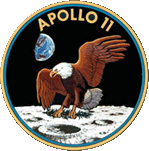 For the 50th anniversary of human- kind's first walk on another world, check out these awesome interac- tive adventures: First Men on the Moon, Apollo 11 in
Real-Time and Mapping the Mission.
Then view the Command Module in 3-D, its interior and the LEM on the Moon in 3-D! Sadly, the awesome "We Choose the Moon", an excellent recre- ation written in Flash, can no longer be found on the net. Truly a great loss.
For the 50th anniversary of human- kind's first walk on another world, check out these awesome interac- tive adventures: First Men on the Moon, Apollo 11 in
Real-Time and Mapping the Mission.
Then view the Command Module in 3-D, its interior and the LEM on the Moon in 3-D! Sadly, the awesome "We Choose the Moon", an excellent recre- ation written in Flash, can no longer be found on the net. Truly a great loss.
That's how the Total Solar Eclipse of 21 August 2017 was described. That Monday the Moon's shadow whisked across the United States, gracing it with a true sky marvel! Here are some excellent videos of it!
NASA Page
PDF
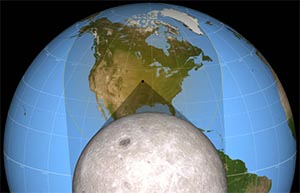
Awesome online app and animations from NASA:
Path on Rectangular World Day-Night Map
Why Eclipses Occur Oblique View ![]()
MORE GREAT MOON LINKS
APOLLO Missions: high resolution posters
ONE SMALL STEP: Apollo 11
APOLLO Manned Lunar Landing Mission Profile
DESTINATION MOON
Here's a link to a nice NASA page: Timeline of Lunar Exploration Missions. Lots of good background info here!
Here's a link to a nice Lunar Panorama from Apollo 17 in color. Yes, that's a barren-looking place! Can you find the Rover?
SAME SIDE OF THE MOON
ALWAYS FACES EARTH
TOUR OF THE MOON
video credit: NASA/Goddard Space Flight Center
EVOLUTION OF THE MOON
video credit: NASA/Goddard Space Flight Center
LUNAR CRATERS
video credit: NASA/Goddard Space Flight Center
MORE GREAT MOON VIDEOS
Apollo Landing Sites shows Moon phases during missions.
LRO Takes the Moon's Temperature
Lunar Clementine Moon Spin. Video Credit: NASA/Goddard Space Flight Center Scientific Visualization Studio
Clementine Lunar South Pole. Video Credit: NASA/Goddard Space Flight Center Scientific Visualization Studio
Lunar Prospector Hydrogen Concentration - South Pole. Video Credit: NASA/Goddard Space Flight Center Scientific Visualization Studio
Apollo Mission Lunar Surface Footage. Video Credit: NASA/Johnson Space Center
Home Intro News Gallery Sky-Gifts Bonuses Tips
Learning Ctr Help Links Credits Legal Contact Us
© 2007-
by Gary M. Winter. All rights reserved.
Interested in political cartoons and humor?
Check out The HIPPLOMATS™.
Current Sunsize vs Moonsize, SUN and MOON Current Apparent Sizes, Current Geocentric Apparent Sizes of the Sun and Moon. GREAT AMERICAN ECLIPSE! BEST ECLIPSE IN AMERICAN HISTORY! BEST ECLIPSE IN U.S. HISTORY! BEST ECLIPSE IN US HISTORY! SkyMarvels, Sky Marvels, SkyMarvels.com, MOON Info, THE MOON! View its Current Distance, Current Apparent Size, Current Phase, Current Position in Orbit, Eclipses, Eclipse Calendar, Interactive Eclipse Seasons Calendar, Eclipse Seasons, Upcoming Eclipses and much more! Supermoons & Extreme Perigean Tides 2020-2021! celestia4all, celestiaforall, CELESTIA, astronomy, space, simulations, animations, downloadable astronomy posters, stars, planets, Inner Planets, Outer Planets, Inferior Planets, Superior Planets, moons, asteroids, comets, Oort Cloud, galaxy, galaxies, Milky Way, Andromeda, globular clusters, binaries, quasars, black holes, supermassive black holes, telescope, telescopes, planetarium, software, freestuff, satellites, add-ons, addons, scripts, eclipses, Solar Eclipses, Lunar Eclipses, Solar Eclipse Finder, Lunar Eclipse Finder, mutual eclipses, transits, occultations, Solar System, CELES-TOOLS, celeSTARrium, CELX, CELX programming, Freebies, Bonuses, multiple views, atronomical unit, light year, parsec, meteors, meteor showers, Perseids, Geminids, Leonids, barycenter, time, Time Zones, tides, alignments, conjunctions, oppositions, seasons, apogees, perigees, aphelion, perihelion, Earth, Luna, Mercury, Venus, Mars, Jupiter, Galilean Moons, Io, Europa, Ganymede, Callisto, Saturn, Titan, rings, Uranus, Neptune, Triton, E-MSpectrum, electromagnetic spectrum, astronaut, equinoxes, solstices, precession, rotation, spin, inclination, tilt, Ecliptic, orbits, ellipse, parabola, hyperbola
"Our Moon is the greatest influence on Earth's tides."
Earth's & our Moon's motion around their barycenter helps produce Earth's tides.
Current Moon
![]()
![]()
Location in the Constell.
Moon Phaser
(to update, reload page)
Current Apparent Sizes
(geocentric)

 K E E P S A F E! It is never NEVER safe to
K E E P S A F E! It is never NEVER safe to
look directly at the real Sun with the naked
eye! Moreover, looking at it—even for an instant—
through a telescope, binoculars, camera or similar
instrument without adequate safeguards can cause
permanent blindness! NEVER DO IT! To learn how
you can safely "observe" the Sun, consult the pro-
fessionals at your local planetarium or observatory.
Donate safely with: PayPal
and receive one or more
Sky-Gifts. Your support is greatly appreciated!
NOTE: you do not need a PayPal account to donate.
SKY VIEWING
SOLAR SYSTEM
THE SUN
MERCURY
VENUS
EARTH
THE MOON
MARS
JUPITER
SATURN
URANUS
NEPTUNE
SMALLER WORLDS
STELLAR OBJECTS
EXOPLANETS
DEEP-SKY OBJECTS
SCALE OF THE COSMOS
———————
SKY-FUN / SKY-GAMES
UPCOMING:
Eclipses: Solars are Partials;
Lunars are Totals.
Lunar Occultations: IOTA
MOON INTERACTIVES
QUICK ACCESS LIST
Note: some links are echoed elsewhere on this page and may include descriptive text.
NASA's Moon Overview (in cool interactive 3-D!)
Your Moonrise, Moonset, Sunrise & Sunset today.
Soar above the Moon with awesome LROC QuickMap
Links to interactive features that show the Moon's orbit in 3-D can be found on our Solar System page
Study Moon Phases w/ these interactives: #1 #2 #3
More Lunar Phase Sims:
#1 #2 Moon Phaser
NASA's Moon Trek mapping application
Study the Moon's surface with NASA's Lunar Recon- naissance Orbiter Camera
Note: We Choose the Moon,
a terrific Flash app, is no longer on net. A great loss.
And don't forget to look over directly to the left column for a few more cool interactives!
MOON FUN FACTS
The Moon is moving away from Earth by about 4 centi- meters (about 1½ inches) per year! So the length of lunar months is increasing!
On average, the Moon's re- flectivity is about that of a well-worn asphalt road.
The Moon moves in its orbit at an average speed of about 3,600 kmh (2300 mph)! That's roughly the maximum speed of the SR-71, the fastest jet plane ever flown by man!
And yet, most persons can run faster than the Moon ro- tates at its equator!
Essentially the same side of the Moon always faces us here on Earth because, over eons, gravitational forces have synchronized the lunar spin and orbit!
The "dark side of the Moon" is an often mis-used term,
for the Moon's dark half is constantly changing due to the lunar rotation! So the "dark side of the Moon" (or part of it) can actually be seen from Earth most of the time! Often the term "dark side of the Moon" is used incorrectly when what is actually meant is the "far side of the Moon."
With few maria, the Moon's far side looks very different from the side facing Earth.
The lunar core is believed to be quite small and not quite at the center of the Moon!
Like immense brake shoes, the tides are slowing Earth's spin! At the same time this "synchronizing effect" also causes the lunar orbit to slow and the Moon to gradually re- cede from Earth—at a rate of a few centimeters per year! So, far in the future, the same side of Earth will always face the Moon, and a day and a month will be equal in length—about fifty Earth days long!
Seen from Earth, the Moon's phase is shown above (near top) at "Current Moon". Seen from the Moon, our "Earth's" phase is shown (at upper
left) as the "Moon's Position Over Earth". These phases are always complements of each other!
WHAT CAUSES MOON PHASES
Study Moon Phases w/ these interactives: #1 #2 #3
MOON MISC.
TIDES
Tides are our planet's peri- odic variations in water level, produced by the gravitational pull of the Sun and the Moon, and the "centrifugal effect"
(actually a manifestation of "inertia") generated by the Moon's and Earth's motion around their barycenter.
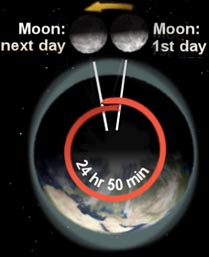 Because the Moon orbits in the direction of Earth's spin, our planet must spin more than 24 hours (50 minutes more) for a point "under the Moon" one day to "return there" the next. Thus, for "ideal" tides, about 12 hr 25 min elapses from one high tide to the next, or one low tide to the next.
Because the Moon orbits in the direction of Earth's spin, our planet must spin more than 24 hours (50 minutes more) for a point "under the Moon" one day to "return there" the next. Thus, for "ideal" tides, about 12 hr 25 min elapses from one high tide to the next, or one low tide to the next.
The following sites provide details on tides: their types, causes, frequencies, etc.
NOAA What are Spring & Neap Tides? ![]()
NOAA What is a Perigean Spring Tide? ![]()
And from EarthSpaceLab, its awesome Tidal Phenomena lets you study tides in 3-D!
And don't forget—you can learn more with our Earth's Tides Poster, which is always available as a Sky-Gift.
LUNAR APOGEES & PERIGEES
Lunar apogees & perigees show just how irregular the lunar orbit is. From 1500 to 2500 CE, the Moon's apogees average roughly 405,400 km, varying from about 404,050 km to an extreme maximum of about 406,720 km. Lunar perigees however, as can be seen in the graph just to the left, are a bit more variable. Averaging about 363,400 km, they can vary from roughly 370,350 km to an extreme minimum of about 356,370 km! This means that, while the Moon's apogees vary by less than 2,700 km, its peri- gees vary by over five times as much—almost 14,000 km!
Charting lunar perigees is particularly important in tide prediction. Tides that occur close to the times of a lunar perigee (Perigean Tides) can be substantially higher than average and produce signif- ican shore erosion. This is especially true if they occur near Full or New Moons, at which times the gravities of the Sun and Moon's pull on our planet essentially along the same axis. This results in Perigean Spring Tides ![]() , and these are stronger still. They recur about every 6½
, and these are stronger still. They recur about every 6½
to 7 months, thus returning
a little later on our calendar each year.
It is worth noting that the most extreme lunar apogees and perigees tend to happen in the winter months of the Northern Hemisphere. This is when Earth is nearest its perihelion, i.e. closest (yes, closest!) to the Sun. Extreme apogees tend to happen when the Moon is New, since the Sun pulls it "away from" Earth. Extreme perigees in contrast tend to occur when the Moon is Full, as the Sun pulls it "toward" Earth.
SKYMARVELS™
ADD-ONS FOR CELESTIA FEATURING THE MOON
SKYMARVELS™
POSTERS FEATURING THE MOON
SKYMARVELS™
VIDEOS FEATURING THE MOON
Solar Eclipses:
Lunar Eclipses:
Moon's Occultation of Venus 2010 May 16
Moon's Occultation of Venus 2010 Sep 11
The Same Side of the Moon Always Faces Earth